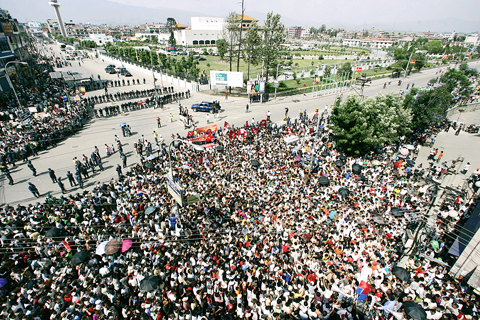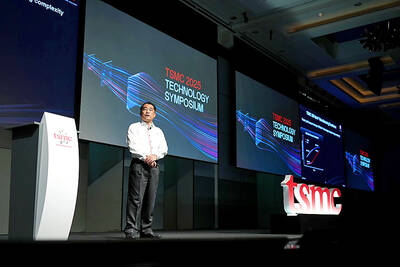Nepal was set for historic change yesterday with a new assembly dominated by former Maoist rebels poised to sweep away the Himalayan kingdom’s 240-year-old monarchy and declare a republic.
The key session, however, was being held up amid wrangling between the former rebels and mainstream political parties over who should be the impoverished nation’s first president, officials said.
Tensions were also rising in the capital, with police using tear gas to disperse protesters demanding that unpopular King Gyanendra be given the boot as scheduled, an AFP reporter at the scene said.

PHOTO: AP
In spite of a ban on gatherings outside the complex where the new constitutional body was set to meet, thousands of people thronged the area to celebrate Nepal’s first “republic day.”
“We are here to put pressure on them to announce a republic quickly,” said Mohan Ghising, 48, a Maoist political worker who was part of group waving large red flags emblazoned with a hammer-and-sickle. “We don’t want them to delay.”
“This is a golden day for Nepal and Nepalese. It’s the end of an era and the start of a new era,” said Sagar, the leader of the Maoists’ Young Communist League, which has mobilized thousands of its supporters.
But last-minute jockeying for places in Nepal’s new political landscape was holding up the historic moment, originally scheduled to take place in the morning.
“The meeting will be further delayed until they reach an agreement,” said Ananta, a deputy commander of the Maoist People’s Liberation Army.
Sources close to the talks said the country’s elderly prime minister, the mainstream politician Girija Prasad Koirala, wanted to be president but that the Maoists were objecting.
The constitutional assembly’s first meeting will be the culmination of a 2006 peace deal that brought the Maoists out of the hills and jungles and into the mainstream.
The Maoists have told Gyanendra and his son, Crown Prince Paras — loathed for his alleged playboy lifestyle — to bow out gracefully or else face “strong punishment.”
Gyanendra was crowned after the 2001 slaying of his popular brother Birendra and most of the royal family during a rampage by a drink-and-drug-fueled crown prince who later killed himself.
Maoist spokesman Krishna Bahadur Mahara said the king would have a deadline of seven to 15 days to vacate the palace. But tensions are high, with police blaming die-hard royalists for a string of small bomb attacks this week.
Although seen by loyalists as the reincarnation of a Hindu god, Gyanendra never managed to win much support from the public, having been falsely seen by many people as somehow involved in the palace killings.
His status was further damaged by his ill-fated decision to seize absolute power to fight the Maoist rebellion.

DEMOGRAPHICS: Robotics is the most promising answer to looming labor woes, the long-term care system and national contingency response, an official said Taiwan is to launch a five-year plan to boost the robotics industry in a bid to address labor shortages stemming from a declining and aging population, the Executive Yuan said yesterday. The government approved the initiative, dubbed the Smart Robotics Industry Promotion Plan, via executive order, senior officials told a post-Cabinet meeting news conference in Taipei. Taiwan’s population decline would strain the economy and the nation’s ability to care for vulnerable and elderly people, said Peter Hong (洪樂文), who heads the National Science and Technology Council’s (NSTC) Department of Engineering and Technologies. Projections show that the proportion of Taiwanese 65 or older would

Nvidia Corp yesterday unveiled its new high-speed interconnect technology, NVLink Fusion, with Taiwanese application-specific IC (ASIC) designers Alchip Technologies Ltd (世芯) and MediaTek Inc (聯發科) among the first to adopt the technology to help build semi-custom artificial intelligence (AI) infrastructure for hyperscalers. Nvidia has opened its technology to outside users, as hyperscalers and cloud service providers are building their own cost-effective AI chips, or accelerators, used in AI servers by leveraging ASIC firms’ designing capabilities to reduce their dependence on Nvidia. Previously, NVLink technology was only available for Nvidia’s own AI platform. “NVLink Fusion opens Nvidia’s AI platform and rich ecosystem for

Taiwan Semiconductor Manufacturing Co (TSMC, 台積電) yesterday said it is building nine new advanced wafer manufacturing and packaging factories this year, accelerating its expansion amid strong demand for high-performance computing (HPC) and artificial intelligence (AI) applications. The chipmaker built on average five factories per year from 2021 to last year and three from 2017 to 2020, TSMC vice president of advanced technology and mask engineering T.S. Chang (張宗生) said at the company’s annual technology symposium in Hsinchu City. “We are quickening our pace even faster in 2025. We plan to build nine new factories, including eight wafer fabrication plants and one advanced

‘WORLD’S LOSS’: Taiwan’s exclusion robs the world of the benefits it could get from one of the foremost practitioners of disease prevention and public health, Minister Chiu said Taiwan should be allowed to join the World Health Assembly (WHA) as an irreplaceable contributor to global health and disease prevention efforts, Minister of Foreign Affairs Lin Chia-lung (林佳龍) said yesterday. He made the comment at a news conference in Taipei, hours before a Taiwanese delegation was to depart for Geneva, Switzerland, seeking to meet with foreign representatives for a bilateral meeting on the sidelines of the WHA, the WHO’s annual decisionmaking meeting, which would be held from Monday next week to May 27. As of yesterday, Taiwan had yet to receive an invitation. Taiwan has much to offer to the international community’s